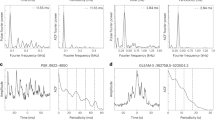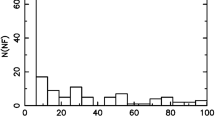Abstract
Several conjectures have been put forward to explain rotating radio transients (RRATs), the newest subclass of neutron stars, and their connections to other radio pulsars. This work discusses these conjectures in the context of the characteristic properties of the RRAT population. Contrary to expectations, it is seen that: (a) the RRAT population is statistically un-correlated with the nulling pulsars and (b) the RRAT phenomenon is unlikely to be related to old age or death-line proximity. It is perhaps more likely that the special emission property of RRATs is a signature of them being later evolutionary phases of other types of neutron stars which may have resulted in restructuring their magnetic fields.








Similar content being viewed by others
References
Archibald R. F., et al. 2017, ApJ, 849, L20
Backer D. C. 1970, Nature, 228, 42
Bhattacharya D., Wijers R. A. M. J., Hartman J. W., Verbunt F. 1992, A &A, 254, 198
Bhattacharyya B., et al. 2018, MNRAS, 477, 4090
Burke-Spolaor S., Bailes M. 2010, MNRAS, 402, 855
Burke-Spolaor S., et al. 2011, MNRAS, 416, 2465
Burke-Spolaor S., et al. 2012, MNRAS, 423, 1351
Chen K., Ruderman M. 1993, ApJ, 402, 264
Chowhan T. T., Konar S., Banik S., 2022, in Neutron Star Astrophysics at the Crossroads: Magnetars and the MultimesMultimessenger Revolution, eds. Troja E., Baring M., Proceedings of IAU Symposium No. 363 (in press)
Cordes J. M., Shannon R. M. 2008, ApJ, 682, 1152
Cui B. Y., Boyles J., McLaughlin M. A., Palliyaguru N. 2017, ApJ, 840, 5
Deneva J. S., Stovall K., McLaughlin M. A., et al. 2013, ApJ, 775, 51
Esamdin A., Abdurixit D., Manchester R. N., Niu H. B. 2012, ApJ, 759, L3
Gençali A. A., Ertan Ü. 2018, MNRAS, 481, 244
Good D. C., et al. 2021, ApJ, 922, 43
Hessels J. W. T., Ransom S. M., Kaspi V. M., et al. 2008, in American Institute of Physics Conference Series, Vol. 983, 40 Years of Pulsars: Millisecond Pulsars, Magnetars and More, eds. Bassa C., Wang Z., Cumming A., Kaspi V. M., p. 613
Hewish A., Bell S. J., Pilkington J. D. H., Scott P. F., Collins R. A. 1968, Nature, 217, 709
Jawor J. A., Tauris T. M. 2022, MNRAS, 509, 634
Kaplan D. L., Esposito P., Chatterjee S., et al. 2009, MNRAS, 400, 1445
Kaspi V. M. 2010, Proceedings of the National Academy of Science, 107, 7147
Keane E. F., Kramer M. 2008, MNRAS, 391, 2009
Keane E. F., Ludovici D. A., Eatough R. P., et al. 2010, MNRAS, 401, 1057
Keane E. F., McLaughlin M. A. 2011, Bulletin of the Astronomical Society of India, 39, 333
Keane E. F., Kramer M., Lyne A. G., Stappers B. W., McLaughlin M. A. 2011, MNRAS, 415, 3065
Keane E. F. 2016, MNRAS, 459, 1360
Knight H. S., Bailes M., Manchester R. N., Ord S. M., Jacoby B. A. 2006, ApJ, 640, 941
Konar S., Bhattacharya D. 1997, MNRAS, 284, 311
Konar S., Bhattacharya D. 1999, MNRAS, 303, 588
Konar S. 2012, in COSPAR Meeting, Vol. 39, 39th COSPAR Scientific Assembly, p. 961
Konar S. 2013, in Astronomical Society of India Conference Series, Vol. 8, eds. Das S., Nandi A., Chattopadhyay I., Astronomical Society of India Conference Series, p. 89
Konar S., et al. 2016, JoAA, 37, 36
Konar S. 2017, JoAA, 38, 47
Konar S., Deka U. 2019, JoAA, 40, 42
Li X.-D. 2006, ApJ, 646, L139
Logvinenko S. V., Tyul’bashev S. A., Malofeev V. M. 2020, Bulletin of the Lebedev Physics Institute, 47, 390
Lu J., et al. 2019, Science China Physics, Mechanics and Astronomy, 62, 959503
Luo Q., Melrose D. 2007, MNRAS, 378, 1481
Lyne A. G., McLaughlin M. A., Keane E. F., et al. 2009, MNRAS, 400, 1439
Manchester R. N., Hobbs G. B., Teoh A., Hobbs M. 2005, VizieR Online Data Catalog, 7245, 0
McLaughlin M. A., et al. 2006, Nature, 439, 817
McLaughlin M. A., et al. 2007, ApJ, 670, 1307
McLaughlin M. A., et al. 2009, MNRAS, 400, 1431
Miller J. J., McLaughlin M. A., Rea N., et al. 2013, ApJ, 776, 104
Popov S. B., Turolla R., Possenti A. 2006, MNRAS, 369, L23
Rea N., et al. 2009, ApJ, 703, L41
Rea N., et al. 2010, MNRAS, 407, 1887
Ritchings R. T. 1976, MNRAS, 176, 249
Ruderman M. A., Sutherland P. G. 1975, ApJ, 196, 51
Shitov Y. P., Kuzmin A. D., Dumskii D. V., Losovsky B. Y. 2009, Astronomy Reports, 53, 561
Tyul’bashev S., Kitaeva M., Logvinenko S., G. E. T. 2021, Astronomy Reports (in press)
Tyul’bashev S. A., Tyul’bashev V. S., Malofeev V. M. 2018, A&A, 618, A70
von Mises R. 1980, Mathematical Theory of Probability and Statistics (Academic Press: New York)
Weltevrede P., Stappers B. W., Rankin J. M., Wright G. A. E. 2006, ApJ, 645, L149
Weltevrede P., Johnston S., Espinoza C. M. 2011, MNRAS, 411, 1917
Young N. J., Weltevrede P., Stappers B. W., Lyne A. G., Kramer M. 2014, MNRAS, 442, 2519
Acknowledgements
We thank Priya S. Hasan and S. N. Hasan whose 2020 workshop on ‘Astronomy from archival data’ as part of an IAU-OAD project, helped to bring the authors of this work together.
Author information
Authors and Affiliations
Corresponding author
Appendix. The RRATs
Appendix. The RRATs
Table 5 lists the known RRATs, detected till date, which we have used for our calculations in this work. Majority of the sources are obtained from the RRATalog site maintained by Bingyi Cui and Maura McLaughlin. For the rest, discovery papers have been referred. The parameter values for spin period (\(P_s\)), dispersion measure (DM), characteristic age (\(\tau _c\)) and surface dipolar field (\(B_s\)) are taken from the ATNF pulsar catalog (Manchester & Hobbs 2005), except where the objects are not yet included in the ATNF list. Parameter values for these second set of objects are taken from the discovery papers and the references are marked with a -P. For some sources, different names have been used by different groups. We have primarily used the ATNF names and indicated the alternative names in the ‘Other-Name’ column. The references cited in the tables with numbers ranging from 1 to 9 correspond to the following:
-
(1)
RRATalog (last update September 2016);
-
(2)
Weltevrede et al. (2011);
-
(3)
Esamdin et al. (2012);
-
(4)
Deneva et al. (2013);
-
(5)
Cui et al. (2017);
-
(6)
Tyul’bashev et al. (2018);
-
(7)
Good (2021);
-
(8)
Logvinenko et al. (2020);
-
(9)
Tyul’bashev et al. (2021).
RRATalog: http://astro.phys.wvu.edu/rratalog/
Rights and permissions
About this article
Cite this article
ABHISHEK, MALUSARE, N., TANUSHREE, N. et al. Radio pulsar sub-populations (II): The mysterious RRATs. J Astrophys Astron 43, 75 (2022). https://doi.org/10.1007/s12036-022-09862-3
Received:
Accepted:
Published:
DOI: https://doi.org/10.1007/s12036-022-09862-3




